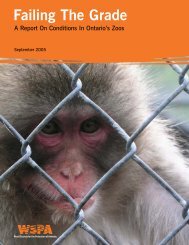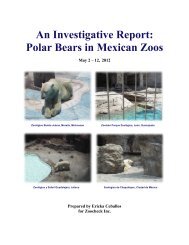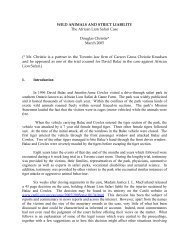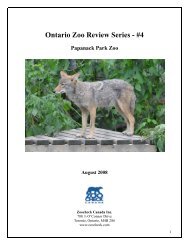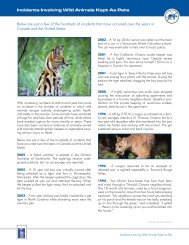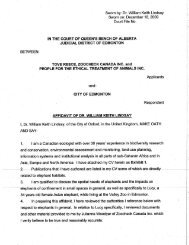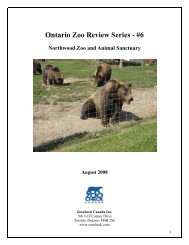What's a Polar Bear Doing in the Tropics? - Animal Concerns ...
What's a Polar Bear Doing in the Tropics? - Animal Concerns ...
What's a Polar Bear Doing in the Tropics? - Animal Concerns ...
Create successful ePaper yourself
Turn your PDF publications into a flip-book with our unique Google optimized e-Paper software.
Startpo<strong>in</strong>tLand areaWaterfallKicks offswimm<strong>in</strong>gon back,<strong>the</strong>n divesdownOverhang<strong>in</strong>gBoulderSwims underthis boulderPoolUnderwaterBoulderSwims on <strong>the</strong>surface toboulder wherehe rests for afew secondsThe stereotypic swimm<strong>in</strong>g route most commonly used by Inuka.response termed ‘learned helplessness’. 58 This <strong>in</strong>volves <strong>the</strong> shift of <strong>the</strong>behaviour of <strong>the</strong> animals from an active state <strong>in</strong>to a more passive, <strong>in</strong>activestate.Both Sheba and Inuka have been recorded display<strong>in</strong>g various abnormalstereotypic behaviours <strong>in</strong>clud<strong>in</strong>g pac<strong>in</strong>g and swimm<strong>in</strong>g <strong>in</strong> a stereotypicfashion. Sheba also appears to have developed a chronic tongue play<strong>in</strong>ghabit (constant manipulation of <strong>the</strong> tongue with no apparent purpose),which has been recognised as a form of stereotypic behaviour. 59,60Stereotypic behaviours are repeatedly performed, relatively <strong>in</strong>variantmovement patterns with no apparent function or goal. 61 These behavioursare clearly an <strong>in</strong>dication of an abnormal animal-environment <strong>in</strong>teraction. 7For most wild mammals <strong>in</strong> captivity, this probably means that <strong>the</strong> animalgrew up <strong>in</strong> or is currently liv<strong>in</strong>g <strong>in</strong> an environment suboptimal for meet<strong>in</strong>g itsnatural, species-specific behavioural needs. 7 These stereotypic behavioursare almost unique to captive animals. 59Stereotypies <strong>in</strong> captive animals have been associated with poor welfare forfive decades. 8 This is because <strong>the</strong>y tend to develop <strong>in</strong> situations that havebeen identified as stressful and aversive. 7,62 On <strong>the</strong> basis of behavioural andphysiological evidence such situations <strong>in</strong>clude lack of stimulation,unavoidable fear or frustration 63 and absence of a resource, or resources,required by <strong>the</strong> animal. 64 Such resource requirements can range from accessWhat’s a polar bear do<strong>in</strong>g <strong>in</strong> <strong>the</strong> tropics?43www.acres.org.sg




